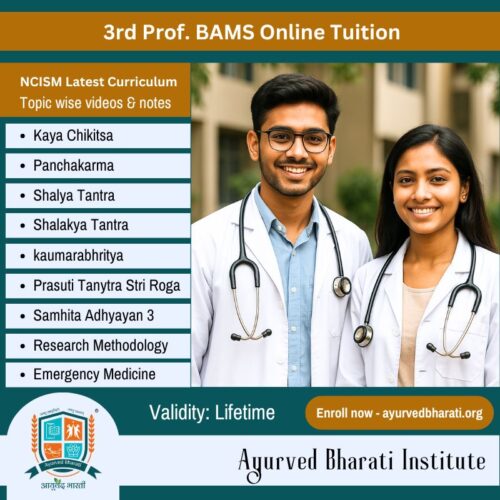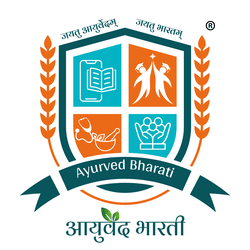Click on curriculum tab to start learning.
Curriculum
- 16 Sections
- 209 Lessons
- Lifetime
Expand all sectionsCollapse all sections
- Introduction & Course Plan3
- Kaya Chikitsa Paper - 17
- 2.1Topic 1 Kaya, Chikitsa and Kayachikitsa – Nirukti, Paribhasha, Paryaya and Bheda
- 2.2Topic 2 Clinical ethics in the practice of Kayachikitsa
- 2.3Topic 3 Samprapti vighatana, Chikitsa sutra, Chikitsa, Aushadha yoga and Pathyaapathya of Jvara
- 2.4Topic 4: Anukta Roga – Treatment Principles based on Dosha-Dushya Vivechana
- 2.5Topic 5: Sankramika Jvara and Zoonotic (Kasheruka-Jeeva-Janya) Diseases
- 2.6Topic 6.1. Chikitsa of Rasa pradoshaja vikara – Pandu roga
- 2.76.2. Hematopoietic diseases
- Kaya Chikitsa Paper - 224
- 3.111.1. Chikitsa of Vatavyadhi – Nirupastambhita and Upastambhita Vata Vyadhi
- 3.211.2. Akshepaka Chikitsa
- 3.311.3. Snayugata Vata
- 3.411.4. Pakshaghata
- 3.511.5. Ekangavata, Sarvanga vata & Sarvanga roga
- 3.611.6. Ardita ( Bell’s Palsy)
- 3.711.7. Jihwastambha
- 3.811.8. Manyastambha
- 3.911.9. Vishwachi
- 3.1011.10. Avabahuka
- 3.1111.11. Gridhrasi (Sciatica)
- 3.1211.12. Kalaya khanja Pangu
- 3.1311.13. Padadaha and Padaharsha
- 3.1411.14. Kaphavruta vata, Medogatavata and Medoavruta vata
- 3.1511.15. Parisareeya nadi shotha (Peripheral Neuropathy)
- 3.1611.16. Urustambha
- 3.1711.17. Udavarta
- 3.1811.18. Guillain- Barre syndrome, Ajnavaha nadikosha vikara (Motor Neuron Disease), Anuprasthiya-sitamajjachadda -shotha (Transverse Myelitis), Peshi dourbalya (Myasthenia Gravis)
- 3.1911.19. Differentiate between the various types of Strokes and apply the treatment principles of Vatavyadhi and Pakshaghata in its management
- 3.2011.20. Gata vata
- 3.2111.21. Importance of Antahparimarjana and Bahirparimarjana chikitsa in Vata vyadhi
- 3.2211.22. Cases of Vatavyadhi
- 3.2311.23. Matra, Sevana kala and Anupana in various clinical condition of Vatavyadhi
- 3.2411.24. Importance of commemorating International Day on Stroke and Arthritis
- Kaya Chikitsa Paper - 312
- 4.1Agnimandya, Aruchi/ Arochaka
- 4.2Ajeerna | Alasaka | Vishuchika | Vilambika
- 4.3Aanaha/ Aatopa/ Aadhmana
- 4.4Amlapitta, Bhasmaka
- 4.5Shoola, Parinama shoola, Annadrava shoola
- 4.6Chhardi
- 4.7Gulma
- 4.8Grahani
- 4.9Annadravashoola-Parinamashoola (Acid peptic disease)
- 4.10Amlapitta (Gastro esophageal reflux disease)
- 4.11Grahani (Irritable Bowel Syndrome)
- 4.12Udarastha karkatarbuda – Malignancies of abdomen (Ca Pancreas, Ca Duodenum/ Stomach)
- Panchakarma10
- Shalya Tantra Paper - 118
- 6.11.1. Definition of Shalya, Shalya Tantra and its Importance
- 6.21.2. Chronological development of surgery from ancient to present era
- 6.31.3. General Scheme of Surgical Case Taking
- 6.41.4. Special signs and symptoms pertaining to surgery
- 6.52.1. Yantra – Nirukti, Prakara, Guna, Prayog, Dosha, Karma, Upayantra and Relevant modern instruments
- 6.62.2. Shastra – Nirukti, Prakara, Guna, Prayog, Dosha, Karma, Anushastra and Relevant modern instruments
- 6.72.3. Demonstration (Comparison and classification with modern instruments)
- 6.83. Nirjantukarana (Sterilization)
- 6.94. Sangyaharana (Anaesthesia)
- 6.105. Trividha Karma (Pre, Operative and Post Operative care)
- 6.116.1. Nirukti, Yogya, Ayogya, Prakara with modern correlations of Chhedan, Bhedan and Lekhan
- 6.126.2. Nirukti, Yogya, Ayogya, Prakara with modern correlations of Eshana, Aaharan and Visravan
- 6.136.3. Nirukti, Yogya, Ayogya, Prakara with modern correlations of Vedhan and Seevan
- 6.146.4. Hands on training on Prathamopachara (First Aid)
- 6.156.5. Demonstration of Chhedan (Excision), Bhedan (Incision), Lekhan (Scraping) on patient/ simulator
- 6.166.6. Demonstration of Vedhan and Visravan
- 6.176.7. Demonstration of Aharan and Eshan (Extraction and Probing) on the patient/ simulator
- 6.186.8. Demonstration of Seevan (Suturing and Knots)
- Shalya Tantra Paper - 24
- 7.11. Asthi Bhagna/ Kanda Bhagna (Fracture) – Nidana, Prakara, Lakshana, Upadrava and Chikitsa
- 7.22. Ansaphalaka Bhagna (Scapula Fracture), Akshakasthi Bhagna (Clavicle Fracture)
- 7.33. Pragandasthi Bhagna (Humerus Fracture), Bahiprakoshthasthi Bhagna (Radius Fracture), Antaprakoshthasthi Bhagna (Ulna Fracture)
- 7.44. Urvasthi Bhagna (Femur Fracture), Janwasthi Bhagna (Patella), Antar Janghasthi and Bahir Janghasthi Bhagna (Tibia and Fibula Fracture)
- Shalakya Tantra Paper - 110
- 8.1Unit 1 — Śarīra & Nidāna Pañcaka of Netraroga
- 8.2Unit 2 — Sāmānya Cikitsā & Kriyākalpa (Netra)
- 8.3Unit 3 — Pañcakarma & Netraroga
- 8.4Unit 4 — Sañjñāharaṇa in Netraroga (Anesthesia in Ophthalmology)
- 8.5Unit 5 — Sandhigata Roga – 1
- 8.6Unit 6 — Sandhigata Roga – 2
- 8.7Unit 7 — Sandhigata Roga – 3
- 8.8Unit 8 — Vartmagata Roga – 1
- 8.9Unit 9 — Vartmagata Roga – 2
- 8.10Unit 10. Vartmagata Roga – 3
- Shalakya Tantra Paper - 210
- 9.1Unit 30. Enumeration, Nidāna Pañcaka and Sādhya-asādhya-tā of Śiroroga
- 9.2Unit 31. Sāmānya Cikitsā of Śiroroga
- 9.3Unit 32. Karṇa Racanā Śarīra, Nidāna Pañcaka and Samānya Cikitsā of Karṇaroga
- 9.4Unit 33. Karnaroga-1
- 9.5Unit 34. Nasa Shareera, Ghranendriya and Nidana Panchaka of Nasaroga
- 9.6Unit 35. Pratiśyāya & Allied Nāsā-roga
- 9.7Unit 36 — Mukha Śarīra & Nidāna Pañcaka of Mukharoga
- 9.8Unit 37. Oṣṭharoga (Diseases of the Lips)
- 9.9Unit 38. Sarvasāra Mukharoga
- 9.10Unit 39. National Oral Health Programme
- Kaumarabhritya28
- 10.1Unit 1.1 Definitions, Scope & Importance, and Core Terminologies of Kaumarabhritya
- 10.2Unit 1.2. Vayobedha
- 10.3Unit 2. Bāla Saṃvardhana (Growth & Development) Topic 1 to 5
- 10.4Unit 2 (continued). Bāla Saṃvardhana — Topics 6–10
- 10.5Unit 3. Part 1. Navajāta Vijñāna (Neonatology) Topic 1 & 2
- 10.63.43 & 3.4. Navajāta Śiśu Paricaryā, Prāṇa-pratyāgamana
- 10.73.5 & 3.6 Term, Pre term, Post term and High Risk Neonate, Examination of newborn, gestational age
- 10.83.7. Ayu Pariksha Vidhi [Assessment of Longevity and Standard of Living]
- 10.93.8.1. Etiology, clinical features and management of Navajata Rogas- Swasavarodha (Respiratory distress)
- 10.103.8.2. Ulbaka (Meconium aspiration syndrome)
- 10.113.8.3. Birth Injuries
- 10.123.8.4. Upaśīrṣaka (Neonatal scalp edema; modern correlation: Caput succedaneum)
- 10.133.8.5. Neonatal Haemorhagic diseases
- 10.143.8.6. Kāmala (Neonatal jaundice)
- 10.153.8.7. Hypoglycaemia
- 10.163.8.8. Akshepaka (Seizures)
- 10.173.8.9. Abhishyanda (Neonatal Conjunctivitis)
- 10.18Unit 4. Stanya Vijnana (Breast Milk) Topic 1. Stanyotpatti
- 10.194.2. Stanyapana (breastfeeding), techniques and contraindications of breastfeeding
- 10.204.3. Stanya Abhava and Complementary feeding 4.4. Stanyapanayana
- 10.214.5. Stanya Dusti, Stanya Kshaya and Stanya Vruddi
- 10.224.6. Stanyadushti Rogas-Ksheeralasaka, Ahiputana and Kumarashosha
- 10.234.7. Concept and practice of Prashana (feeding)
- 10.24Unit 5. Bala Poshana (Child Nutrition) & Vyadhikshamatva (Immunity) Topic 1, 2
- 10.255.3. Assess the status of Dhatu and Dhatu Pradoshaja Vikara
- 10.265.4. Nutritional diet and other topics of points 5-6-7
- 10.275.8. 8. Garbhopakrama, Sutikopakrama, Balaparicharya up to 2 years
- 10.28Unit 6 Kupōṣaṇa Rogas (Nutritional Disorders) in Bāla Topic 1. Phakka Roga, Kumārashoṣa, Karśya, Parigarbhikā, Sthaulya
- Prasuti Tantra20
- 11.1Unit 1 · Strī Viśiṣṭa Śarīra Vijñāna, Topic (a): Introduction to Prasūti Tantra and Strīroga
- 11.21b. Tryavarta Yoni and anatomical insights of Garbhashaya with marma, peshi
- 11.31c. Artavavaha and Stanyavaha Srotas
- 11.41d. Anatomy of Female internal and external genital organs with applied aspects
- 11.51e. Streeshroni (Female Pelvis) -Types, Diameters and Obstetric significance
- 11.6Unit 2. Rutuchakra – Menstrual Cycle topics a, b
- 11.72c. Practices of Rajaswala Paricharya and its potential effects on reproductive health
- 11.82d. Rutukala, Rutumati Lakshana and Rutumati Paricharya with significance & 2f. Rutuvyatita Kala
- 11.92e. Highlights on Beeja Nirmana – Oogenesis, Spermatogenesis
- 11.102g. Phases of Menstrual cycle, Importance of HPO axis in menstrual regulation
- 11.11Unit 3. Garbha Vigyana – Embryology & Fetal Development Topic a.
- 11.123b. Apara (Placenta) and Garbha Nabhinadi (umbilical cord), Garbhodaka (amniotic fluid)
- 11.133c. Garbha Poshana 3d. Fetal nourishment and Fetal circulation
- 11.143e. Masanumasika Garbha Vriddhi
- 11.153f. Garbhashayantara Garbha Sthiti (Fetus-in-utero)
- 11.16Unit 4. Garbhini Vigyana Topic a. Garbhini Nidana
- 11.174b. Physiological changes and Diagnosis of Pregnancy
- 11.184c. Garbhini Paricharya, Prajasthapana gana
- 11.194d. Antenatal care
- 11.204e. Demographic statistics related to Obstetrics
- Stree Roga20
- 12.1Unit 12. Stree Prajanananga Nirmana and Vikruti Topic A: Development of the Female Reproductive System from the Müllerian Duct and Its Anomalies
- 12.212b. Neuroendocrinology of reproduction
- 12.312c. Anatomy and Physiological aspects of Puberty and Menopause
- 12.4Unit 13. Yantra evam Shastra – Instruments a. Types of Yantra (Blunt instruments) and utilization
- 12.513b. Type of Shastra (Sharp instruments) and utilization
- 12.6Gyanecological Instruments Original Photos
- 12.7Unit 14. Stree Rugna Parikshana – Gynaecological Examination a. Gynaecological History taking
- 12.814b. General and systemic examination
- 12.914c. Part 1. Breast examination
- 12.1014c. Part 2. Per abdomen – Obstetric Abdominal Examination
- 12.1114c. Part 3. Per speculum examination
- 12.1214c. Part 4. Per vaginal examination
- 12.1314c. Part 5. Per rectal examination
- 12.14Unit 15. Artava Vyapad – Menstrual Disorders – a. Ashtartava Dushti
- 12.1515b. Anartava (Amenorrhoea)
- 12.1615c. Poly Cystic Ovarian Syndrome (PCOS)
- 12.1715d. Artava Kshaya (Oligomenorrhoea, Hypomenorrhoea)
- 12.1815e. Artava Vruddhi (Polymenorrhoea)
- 12.1915f. Asrugdara (Abnormal Uterine Bleeding)
- 12.20Unit 16. Rajonivritti – Menopause
- Samhita Adhyayan 316
- 13.1Cha. Chi. 1. Rasayana Adhyaya
- 13.2Cha. Chi. 2. Vajikarana Adhyaya
- 13.3Cha. Chi. 3. Jwara Chikitsitam
- 13.4Cha. Chi. 4. Raktapitta Chikitsitam
- 13.5Cha. Chi .5. Gulma Chikitsitam
- 13.6Cha. Chi. 6. Prameha Chikitsitam
- 13.7Cha. Chi. 7. Kushtha Chikitsitam
- 13.8Cha. Chi 8. Rajayakshma Chikitsitam
- 13.9Cha. Chi. 9. Unmada Chikitsitam
- 13.10Cha. Chi.10. Apasmara Chikitsitam
- 13.11Cha. Chi. 11. Kshataksheena Chikitsitam
- 13.12Cha. Chi. 12. Shwayathu Chikitsitam
- 13.13Cha. Chi.13. Udara Chikitsitam
- 13.14Cha. Chi. 14. Arsha Chikitsitam
- 13.15Cha. Chi. 15. Grahani dosha Chikitsitam
- 13.16Cha. Chi. 16. Panduroga Chikitsitam
- Research Methodology7
- Emergency Medicine5
- Downloadable Notes from external resourcesCollected from various external resources (not owned by Ayurved Bharati)15
- 16.1Knowledge of important commonly used Ayurvedic drugs in Prasutitantra and Striroga
- 16.2Prasuti Tantra Part 1 Typed Notes
- 16.3Prasuti Tantra Part 2 Typed Notes
- 16.4Stri Roga Part 1 Typed Notes
- 16.5Stri Roga Part 2 Typed Notes
- 16.6Kaumarabhritya Part 1 Typed Notes
- 16.7Kaumarabhritya Part 2 Typed Notes
- 16.8Samhita Adhyayayn Typed Notes Part 1 – Charaka Chikitsa
- 16.9Samhita Adhyayayn Typed Notes Part 2 – Charaka Kalpa Siddhi Sthan
- 16.10Research Methodology & Medical Statistics Typed Notes
- 16.11Kaya Chikitsa Typed Notes Hindi
- 16.12Kaya Chikitsa Typed Notes English
- 16.13Shalya Tantra Typed Notes English
- 16.14Shalakya Tantra Notes
- 16.15Panchakarma Typed Notes
Instructor


